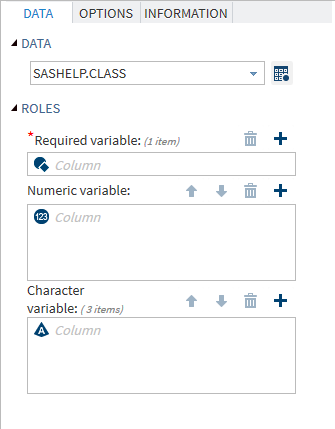Working with the DataSources Element
About the DataSources Element
The
DataSources and DataSource elements
create a simple grouping of the data that is required for the task.
If these elements are not specified, then no input data is needed
to run the task.
The
DataSource element
is the only child of the DataSources element,
and the DataSources element can have only
one DataSource child. The DataSource element
specifies the information about the data set for the task. The only
child for the DataSource element is the Roles element.
Working with the Roles Element
About the Roles Element
The
Roles element
identifies the variables that must be assigned in order to run the
task. This element is a way to group the individual role assignments
that are needed for a task.
The
Role tag,
which is the only child of the Roles element,
describes one type of role assignment for the task.
|
Attribute
|
Description
|
|---|---|
name |
specifies the name assigned
to this role.
|
type |
specifies the type of
column that can be assigned to this role.
Here are the valid
values:
AAll column types are
allowed. In the user interface, all columns are identified by the
 icon. icon.
NOnly numeric columns
can be assigned to this role. In the user interface, numeric columns
are identified by the
 icon. icon.
COnly character columns
can be assigned to this role. In the user interface, character columns
are identified by the
 icon. icon.
|
minVars |
specifies the minimum
number of columns that must be assigned to this role. If
minVars=”0”,
the role is optional. If minVars=”1”,
a column is required to run this task, and a red asterisk appears
next to the label in the user interface.
|
maxVars |
specifies the maximum
number of columns that can be assigned to this role. If
maxVars=”0”,
users can assign an unlimited number of columns to this role.
|
exclude |
specifies the list of
roles that are mutually exclusive to this role. If a column is assigned
to a role in this list, the column does not appear in the list of
available columns for this role.
|
order |
specifies that the user
can order the columns that are assigned to this role. Valid values
are
true and false.
If order=”true”, the user can
use the up and down arrows in the user interface to modify the order.
|
Example: DataSources and Roles Elements from the Sample Task Template
Here is an example
of the
DataSources and Roles elements
from the sample task template:
<DataSources>
<DataSource name="DATASOURCE">
<Roles>
<Role type="A" maxVars="1" order="true" minVars="1"
name="VAR"> Required variable</Role>
<Role type="N" maxVars="0" order="true" minVars="0"
name="OPTNVAR" exclude="VAR">Numeric variable</Role>
<Role type="C" maxVars="3" order="true"
minVars="0" name="OPTCVAR">Character variable<Role>
</Roles>
</DataSource>
</DataSources>A red asterisk appears
for the Required variable role because you
must assign a column to this role. In the code, this requirement is
indicated by
minVars=”1”.
Copyright © SAS Institute Inc. All rights reserved.
